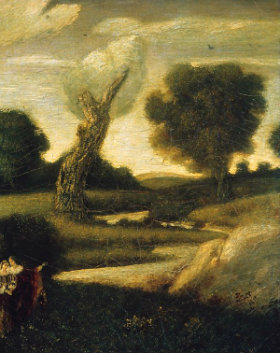Search:: Artists Alphabetically Artists by Country Artists by Century Artists by Movement
Albert Pinkham Ryder
One of the Greatest Painters Of All Time
1847-1917
American Tonalist Painter
Stylistically influenced by the following painters and movements - Symbolism, George Inness, John La Farge, French Barbizon School and Julian Alden Weir
Education - National Academy of Design
Cause of Death - Old Age

Biography of the Artist
Albert Pinkham Ryder was one of the greatest visionary painters of all time. His dreamy, lyrical artworks are the result of a deeply personal vision. Ryder is best known for his spiritually charged religious and literary themed paintings. His subjects were set against backgrounds of shimmering moonlight and poetic, vaporous landscapes. Ryder dismissed the notion that the success of a painting could be measured by how accurately it narrated a story or suggested a message. Instead, he became convinced that a painting was best understood by the emotions it stirred up in the viewer. Ryder was strongly influenced by the writings of Poe, Shakespeare and Voltaire. Like most of the tonalist painters of his generation he favored dream states and psychological experiences over reality.
Technically, Ryder was a bit slipshod in his painting techniques, often working and reworking a canvas for years or even decades. This haphazard approach caused deterioration to the majority of his greatest works. Ryder was something of a recluse as well as a packrat. He rarely cleaned his small dwelling and languished in filth for months, his brushes, paintings, half eaten bits of toast and dirty teacups intermingling in one giant dust ball. Towards the end of his life Ryder's health began to decline and he died at home at the age of 70.
Albert Pinkham Ryder Quote more quotes
Have you ever seen an inch worm crawl up a leaf or twig, and then clinging to the very end, revolve in the air, feeling for something to reach...? That's like me. I am trying to find something out there beyond the place on which I have a footing. - Albert Pinkham Ryder
Description of the Tonalist Painting Style and Technique
Tonalism is rooted in the French Barbizon movement, which emphasized atmosphere and shadow. The Tonalist style employs a distinctive technique by the use of color's middle values as opposed to stronger contrast. Resulting in a understated and compelling overall effect. The tonalist subject matter is never entirely apparent; their is no effort to communicate a message or narrate a story. Instead of relating a story, each sensitively chosen color, composition, and line is arranged to create an intriguing visual poem.
The interiors of tonalist paintings are generally elegant and sparsely decorated, tonally uniform, simplified and indistinct; the figures are usually presented alone in silent contemplation. Landscapes are typically luscious and luminous with evocative atmospheric effects featuring misty backgrounds illuminated by moonlight. Tonalists painters were drawn to both the natural and spiritual realms. They sought to awaken the viewers consciousness by shrouding the subject in a misty indistinct veil of emotionalism. The palette is minimal, characterized by warm hues of brown, soft greens, gauzy yellows and muted grays.
Principle Painters of Tonalism Movement
Ralph
Albert Blakelock American,
1847-1919
Thomas
Wilmer Dewing American, 1851-1938]
Robert
Swain Gifford American,
1840-1905
Alexander
Thomas Harrison American,
1854 -1929
Lowell
Birge Harrison American,
1854-1929
George
Inness American,
1825-1894
John
La Farge American,
1835-1910
Arthur
Frank Mathews American,
1860-1945
John
Francis Murphy American,
1853-1921
Albert
Pinkham Ryder American,
1847-1917
John
Henry Twachtman American,1853-1902
Julian
Alden Weir American,1852-1919
James
Abbott McNeill Whistler American,
1843-1903
Key terms and phrase associated with the tonalist movement - obscured details, single-figure themes, the natural and spiritual domain, waking, unconscious states, sleep, dreams, death, aura, religious significance, emotionalism, emotionalists, pictorial space, compositional space, diffused light, incandescent glow, organic forms, artistic inspiration, illusionist representation, luminous, transcendentalist, glowing, metaphysical, emotional expression, poetic, evocative
Require more facts and information about the painter and the artist? Poke around every nook and cranny of the known universe for information this subject. Search Here
© HistoryofPainters.com If you like this page and wish to share it, you are welcome to link to it, with our thanks.